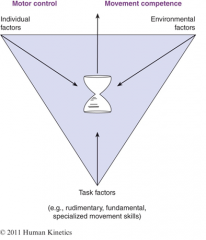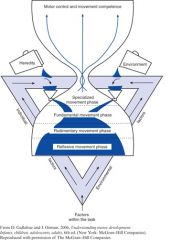![]()
![]()
![]()
Use LEFT and RIGHT arrow keys to navigate between flashcards;
Use UP and DOWN arrow keys to flip the card;
H to show hint;
A reads text to speech;
22 Cards in this Set
- Front
- Back
|
What does the acronym T.I.E. stand for? |
T= task requirements I= individual differences E= environmental factors |
|
|
What is the Transactional Model of Causality in Motor Development and Movement Skill Acquisition? |

|
|
|
What is the stability category of movement? |
Most basic but present in almost all movement. Some developmental issues, like Down Syndrome, can inhibit children from developing key stability skills. |
|
|
What is the locomotion category of movement? |
Movements that involve change in location relative to a fixed point, such as run, jump, hop, skip, leap. Forward or backward roll might be considered to be both locomotive and stability. People with special needs will need to modify their locomotor patterns to compensate. |
|
|
What is the manipulation category of movement? |
Both gross like throwing catching, kicking and striking objects, and fine motor, like sewing cutting with scissors, and typing. |
|
|
What are the two parts of the Motor Development Theoretical Frameworks? |
1) Dynamis systems theory- attempts to answer the "why" questions. Dynamic conveying the concept that developmental change is "nonlinear" and "discontinuous", rather than linear and continuous. It is a continuous process and individual change over time is not necessarily smooth. People with special needs in particular will have developmental delays. Systems means that it is composed of several sub systems, namely the task, individual factors, and the environment.
2) Phases of motor development: Serves as a window for viewing motor development, not an absolute, but a guide to view typical sequential progression when developing motor abilities. |
|
|
What are affordances in Dynamic Systems Theory: |
Enabling factors.
|
|
|
What are rate limiters in Dynamic Systems Theory: |
Inhibiting factors. |
|
|
What are the phases of motor development? |
Reflexive, rudimentary, fundamental, specialized. |
|
|
What is the reflexive movement phase? |
Involuntary, where the infants gain information about the environment in the early months of life. Information encoding stage (in utero to 4 months) lower brain centers are more developed than the motor cortex. Reflexes serve as the primary means through which the infant gathers information, seeks nourishment, and seeks protection.
Information- decoding stage: 4 months to 1 years Lower brain centers are gradually relinquishing control over skeletal movements Decoding replaces sensory activity with perceptual motor behavior.
|
|
|
Rudimentary Movement Phase |
More maturely defined behaviors: Reflex inhibition stage (Where more and more movements are being controlled by developing cortex) (birth to 1 year).
Precontrol stage, where most children begin to bring greater control and precision to their movements. (1 to 2 years). Developmental Divergence: A number of disabling conditions exist that place an infant or toddler at risk for delayed development of rudimentary movements. CNS disorders, orthopedic conditions, mental disability, and sensory impairment, can all hinder motor development during the initial phase of voluntary movement. Intervention strategies can help minimize such delays, by incorporating auditory cues where visual cues usually exist etc. But don't panic... some children are delayed and can catch up. |
|
|
Fundamental Movement Phase: |
Initial stage- child's first goal-oriented attempts at performing a fundamental skill (2-3 years)
Elementary stage- greater control and better rhythmic coordination (4 to 5 years)
Mature stage- mechanically efficient (6 to 7 years).
Developmental Divergence: Children with disabilities might experience a widening of the gap between them and their peers. This night be due to physical limitations, limited learning capabilities, or inadequate instruction or support. |
|
|
Specialized Movement Phase: |
Transition stage-begin to combine and apply fundamental skills to the performance of specialized skills in sports and recreational settings. (7 to 10 years)
Application stage- increased cognitive sophistication and a broadening experience base enabling them to make many learning and participation decisions based on a variety of factors. (11 to 13 years)
Lifelong utilization stage-pinnacle of the motor development process. Interests, competencies, and choices made during the previous stage are carried over to this stage and refined into adulthood. (14 years and up) |
|
|
What is Gallahue's life-span model of motor development? |

The hourglass |
|
|
What are some primitive reflexes in infants? |
Moro, asymmetrical tonic neck, babinski, sucking. |
|
|
What are some postural reflexes? |
Supportive reactions, stepping, swimming |
|
|
What is infant reflexive behaviour indicating possible neurological developmental delay: |
Nonexistance of reflex response, weakness of reflex response, asymmetrical reflex response, persistence of reflex response. ie RAS reflex anoxic seizure: Abrupt interruption in the supply of energy to the cerebral cortex. It can be a result of either a sudden reduction in the blood flow to the brain, or a drop in oxygen content of the blood supply to the brain, or both. |
|
|
Selected Rudimentary Movement Abilities (stability): |
Control of head and neck, control of trunk, sitting, standing. |
|
|
Selected Rudimentary movement abilities (locomotor): |
Horizontal movements Upright gait. |
|
|
Selected rudimentary movement abilities: |
Reaching, grasping, releasing. |
|
|
Selected fundamental movement abilities (manipulative): |
Throwing, catching, kicking, striking. |
|
|
Selected fundamental movement abilities (locomotor): |
Running, jumping, hopping, galloping. |

